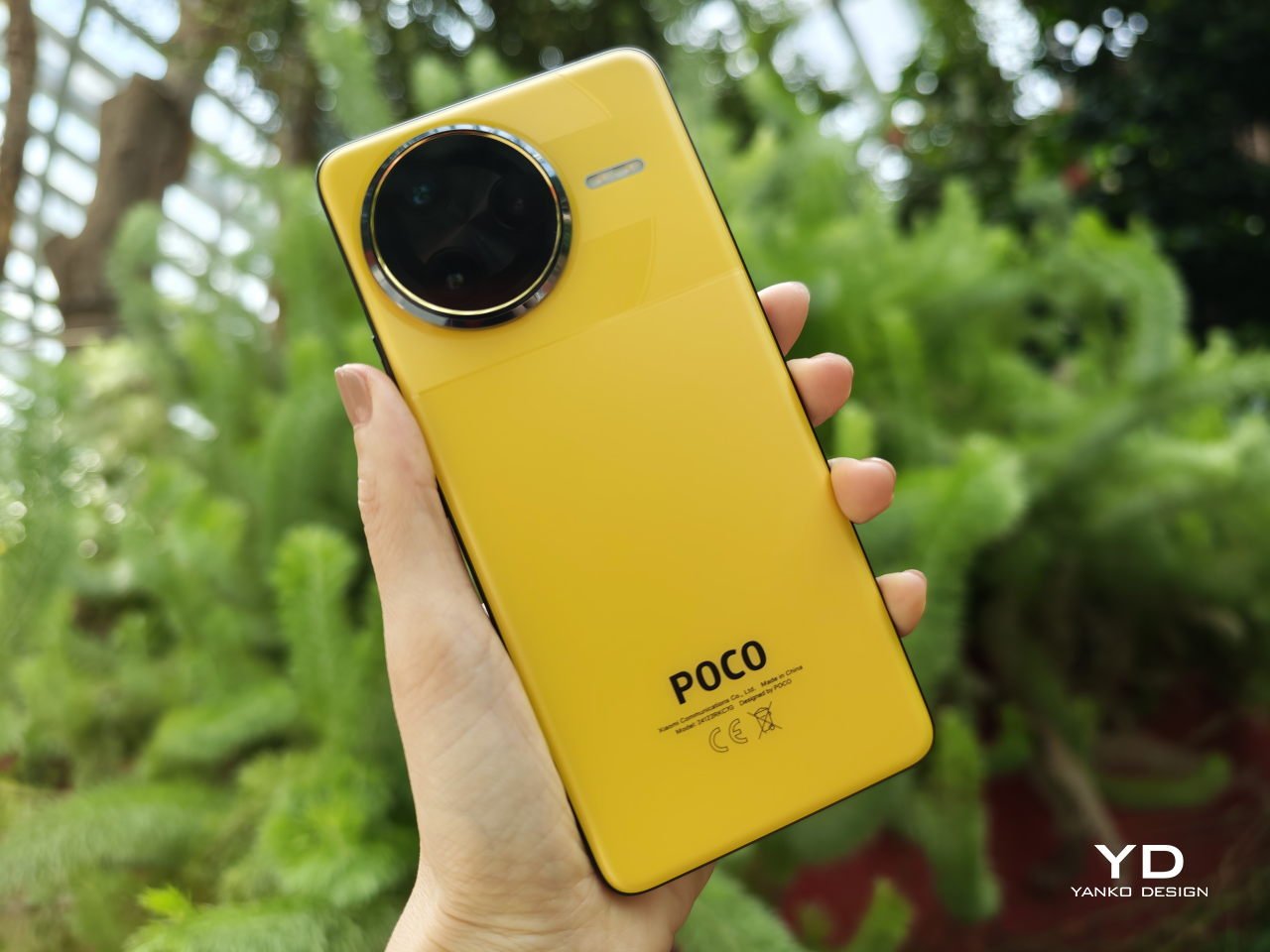PROS:
Fast 120W wired and 50W wireless charging
Bright and vibrant display
CONS:
Modest battery size compared to its competitors
Originally launched as a sub-brand of Xiaomi in 2018, Poco has steadily built its own identity by offering powerful smartphones at highly competitive prices. Over the years, it has earned a loyal following by consistently delivering impressive features without the premium price tag. Now, with the Poco F7 Ultra, the brand is stepping up its game with its first-ever “Ultra” label. This marks a significant milestone, as the coveted “Ultra” tag, usually reserved for Xiaomi’s top-tier devices, such as the Xiaomi 15 Ultra and the Xiaomi SU7 Ultra electric car, makes its debut in the Poco lineup.
As the first phone to carry the prestigious “Ultra” label and the tagline “Unleash Ultra Power,” the Poco F7 Ultra aims to redefine expectations for both performance and design, raising the bar for the brand. This release is set to combine robust performance and cutting-edge technology, making it a serious contender in the crowded mid-range smartphone market. In this review, we’ll take an in-depth look at the Poco F7 Ultra’s design, performance, camera capabilities, and overall value. Will this device continue Poco’s legacy of shaking up the market? Let’s find out.
Designer: Poco
Aesthetics
The design of the Poco F7 Ultra takes a step in a new direction compared to its predecessors. It is available in two color variants — Black and Yellow — and we had the opportunity to review the vibrant Yellow version. Both variants feature a matte glass back with a subtle two-tone effect, giving the phone a fresh and premium look. The black variant has a glossy top section, while the Yellow variant boasts an entirely matte finish. The matte surface feels smooth and comfortable in hand, and it does an excellent job of resisting fingerprints and smudges, which is always a plus.
The circular camera island, which houses the triple-camera setup and IR blaster, is positioned in the top-left corner and sits within an aerospace-grade aluminum deco ring in gunmetal. The cameras are arranged asymmetrically, creating a sense of rhythm, while the radial pattern on the camera island adds visual interest. A subtle gold accent on the camera island further elevates its aesthetic appeal.
A standout design feature is a retro-futuristic pattern that wraps around the top third of the back panel, giving the phone a unique and distinctive look. However, the large logo at the bottom is hard to miss and may feel a bit too bold for some, slightly cluttering an otherwise clean design. Overall, the Poco F7 Ultra offers a distinct design with a few bold details that set it apart from the competition without feeling overly complicated.
Ergonomics
Measuring 160.26 x 74.95 x 8.39 mm and weighing 212g, the Poco F7 Ultra isn’t the lightest or thinnest phone in its category. However, its design doesn’t feel cumbersome. The textured back panel, matte frame, and gently curved edges combine to enhance ergonomics, making the device comfortable to hold for extended periods. While it feels solid and secure in hand, the phone’s width may pose a challenge for one-handed use, especially for those with smaller hands; at least, that was the case for me.
Despite its larger size, the ultrasonic in-display fingerprint sensor is strategically placed for a natural unlocking experience, ensuring a smooth transition from unlocking to using the phone. As for the placements, the volume rocker and power button are located on the right side, while the bottom houses the dual SIM card slot, USB-C port, and main speaker. The other dual stereo speaker is placed at the top.
Performance
Under the hood, the Poco F7 Ultra is powered by Qualcomm’s latest flagship Snapdragon 8 Elite, offering top-tier performance for demanding tasks. To further elevate the device’s capabilities, Poco pairs the Snapdragon 8 Elite with its own dedicated graphics chip, the Vision Boost D7, designed to enhance gaming visuals and provide an exceptional entertainment experience.
When playing graphic-intensive titles like Genshin Impact, the phone handles the game effortlessly at the highest settings, offering a smooth, lag-free experience. While the device does get warm during extended play sessions, it never becomes uncomfortably hot, allowing for prolonged gaming without any noticeable issues. Notably, the camera island remains unobtrusive, ensuring an uninterrupted gaming experience.
The stereo dual speakers offer loud and clear sound, though they may lack some depth in terms of bass. Still, they provide a satisfying audio experience, making the phone ideal for music, videos, or gaming. The F7 Ultra runs Xiaomi HyperOS 2 based on Android 15, and Poco promises up to four major Android updates and six years of security patches, ensuring the device remains up-to-date and secure for years to come.
The Poco F7 Ultra features a versatile triple-camera setup: a 50MP main camera, a 50MP 2.5x telephoto camera, and a 32MP ultra-wide camera. Additionally, it comes equipped with a 32MP front-facing camera designed to capture sharp and clear selfies. The 50MP main camera, equipped with Xiaomi’s Light Fusion 800 image sensor, paired with a large 1/1.55” sensor size and an f/1.6 aperture, captures vibrant, detailed images with minimal noise, even in moderately low light conditions. The camera delivers rich colors and sharpness, though it can sometimes produce slightly overexposed highlights in high-contrast situations.
Complementing the main camera is the 50MP telephoto lens, offering 2.5x optical zoom with an f/2.0 aperture and optical image stabilization (OIS). This telephoto lens also doubles as a macro camera, capable of focusing on subjects as close as 10 cm, making it versatile for both distant shots and intricate close-ups. Photos from this lens are sharp, with fine detail, particularly at zoom up to 5x.
The 32MP ultra-wide camera, with its f/2.2 aperture and 120-degree field of view, is adept at capturing expansive landscapes and group shots. While the image quality is generally solid, there is some softening around the edges of the frame, resulting in a slight loss of detail in wide-angle shots. Overall, while the photos from all three cameras can sometimes be a bit overexposed and overly saturated, they offer good performance for a non-camera-centric device. Considering the Poco F7 Ultra’s price point, the camera system holds its own, delivering good results for most everyday photography needs.
In terms of video, the Poco F7 Ultra supports 8K recording at 24 fps with the main and telephoto cameras, while the ultra-wide and front-facing cameras are limited to 1080p at 60 fps. Furthermore, the lack of 120fps recording, particularly on a device with the ‘Ultra’ label, may be disappointing for some users. While the video quality is generally good, these limitations are unfortunate and somewhat hold back its full potential.
With its 5,300mAh battery, the F7 Ultra comfortably lasts a full day with regular use. It also supports 120W fast wired charging, 50W wireless charging, and reverse wireless charging for other devices. It’s pretty much on par with the latest technologies in this area, but the battery capacity feels a bit too modest given the size of the phone.
Sustainability
When it comes to sustainability and repairability, the Poco F7 Ultra doesn’t appear to have many standout features. While the device doesn’t make any major waves in terms of eco-friendly initiatives, there are some practical durability features worth noting. The IP68 water and dust resistance is a welcome improvement, ensuring the phone can withstand splashes, spills, and dust, adding an extra layer of protection for those who tend to be a bit rough on their devices.
The F7 Ultra also comes equipped with Poco Shield Glass, which the brand claims to be the toughest screen protection ever on one of their devices. This should give users more peace of mind when it comes to handling the phone day-to-day, as it is designed to resist scratches and minor impacts, making the device more resilient to everyday wear and tear. In terms of software support, Poco offers an impressive four major Android updates and six years of security patches, further prolonging the usefulness of the device.
Value
Poco’s first “Ultra” label faces fierce competition in the sub-700 price range. Starting at $649 with 12GB of RAM and 256GB of storage all the way up to just $699 with 16GB of RAM and 512GB, quite a tempting offer for consumers on a tight budget. Other models on this tier include the Vivo iQOO 13 and Realme GT7 Pro, both featuring the Snapdragon 8 Elite in similar form factors, as well as larger batteries and slightly bigger screens with LTPO technology.
However, the Poco F7 Ultra stands out by offering something the iQOO 13 and Realme GT7 Pro don’t—an expansive ecosystem, thanks to its parent company, Xiaomi. For gamers, the iQOO 13 and Realme GT7 Pro feature larger camera bumps that can obstruct gameplay, while the F7 Ultra’s dedicated graphics chip ensures a superior visual experience. Additionally, wireless charging on the Poco F7 Ultra is a notable edge for users who value convenience.
Verdict
The Poco F7 Ultra marks a bold move for the brand as it enters the “Ultra” category. Powered by the Snapdragon 8 Elite, paired with the dedicated Vision Boost D7 graphics chip, and featuring a vibrant 6.67-inch AMOLED display, the F7 Ultra handles demanding tasks with ease, whether you’re gaming or multitasking. It delivers solid performance while offering well-rounded features like a capable triple-camera system, a distinctive design, and 120W wired and 50W wireless fast charging capabilities.
Ultimately, the Poco F7 Ultra is a premium mid-range device that brings impressive features to the table. It excels in gaming, display quality, and performance, while also delivering solid camera capabilities. While it does face stiff competition, it is clear that Poco is pushing its boundaries with this device, setting a new bar for itself and its fans. If you’re in the market for a powerful, well-rounded device that offers a solid performance-to-price ratio, the F7 Ultra is definitely worth considering.
The post Poco F7 Ultra Review: Setting the Bar Higher first appeared on Yanko Design.

